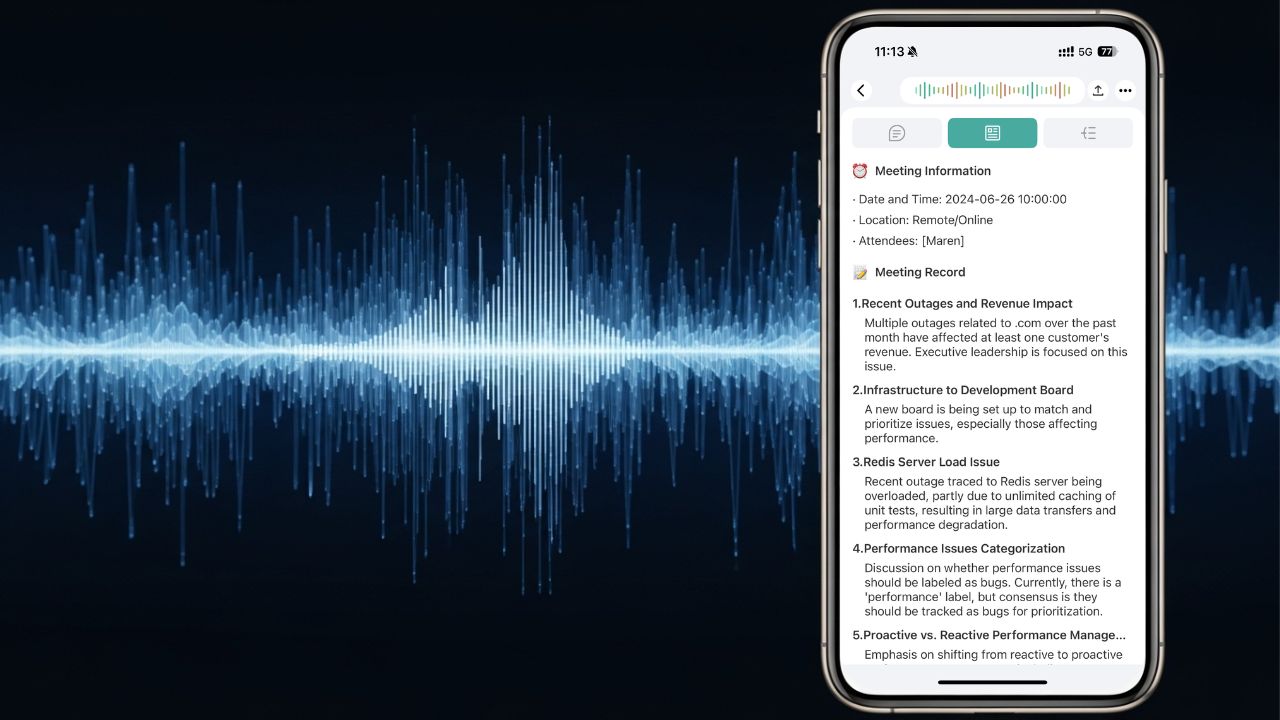Introduction: Why Voice Recorder Transcription Accuracy Matters
Voice-to-text tools have become essential for professionals, students, and creators who rely on accurate transcriptions to save time and streamline their work. Yet, even the best voice recorder devices sometimes produce messy, error-filled transcripts. Why does this happen?
In this article, we’ll cover the top five reasons your transcription accuracy might be low—and how upgrading to an AI-powered recorder can help you achieve clearer, more reliable results than traditional recording devices.
1. Poor Audio Quality from Background Noise
One of the main causes of inaccurate transcriptions is background noise. Whether it’s a noisy café, an echoey conference room, or outdoor sounds, unwanted noise can confuse your transcription software.
Traditional recorders capture everything—coughs, paper rustling, and overlapping voices. This extra noise reduces clarity and forces AI models to guess what was said.
How to fix it:
Choose a voice recorder with built-in noise cancellation, like an AI recorder device that filters ambient sounds.
*Place your device close to the speaker for a stronger signal-to-noise ratio.
*Avoid echo-heavy environments or record indoors when possible.
*Modern AI recorders such as the Ailith AI Recorder isolate voices even in busy settings, dramatically improving transcription accuracy.
2. Overlapping or Multiple Speakers
When more than one person speaks at the same time, voice-to-text transcription often struggles to separate each voice accurately. Traditional recorders can’t identify who’s talking—they simply capture all voices together.
This is especially challenging in meetings, interviews, or group discussions where people interrupt or talk over one another.
How AI recorders help:
Advanced AI recorders use speaker recognition technology to detect and label each participant automatically. Some even generate speaker-specific transcripts, making it easier to review later.
Pro tip: In group settings, encourage clear communication and try to avoid overlapping speech whenever possible.
3. Low-Quality Microphones or Outdated Hardware
Not all recorders are created equal. Many older or inexpensive models have low-quality microphones that fail to capture voices clearly, resulting in muffled or incomplete recordings. Even the best transcription software can’t fix poor input—it’s the classic “garbage in, garbage out” issue.
How to fix it:
Invest in a high-quality AI voice recorder with multiple built-in microphones. Look for features like automatic gain control (AGC) and directional pickup patterns for cleaner sound. Avoid relying solely on smartphone apps for professional transcription tasks—they’re convenient but not always accurate.
AI-powered devices like the Ailith RecNote Recorder combine smart microphones and noise filtering to deliver crystal-clear audio for meetings, lectures, and creative work.
4. Limited AI Language Model or Poor Software Integration
Sometimes the issue isn’t your audio quality—it’s the transcription engine. Older or offline transcription tools often use limited vocabularies or outdated AI models that can’t recognize slang, technical jargon, or diverse accents.
This leads to frequent misinterpretations, especially in specialized fields like law, medicine, or engineering.
How to fix it:
Use transcription tools or devices with cloud-based AI that continually update their language models. Choose a voice recorder with built-in AI transcription instead of relying on third-party tools.
Make sure your AI recorder supports multiple languages if you often record multilingual conversations. Modern recorders like the Ailith AI Recorder use adaptive, cloud-based models that evolve with real-world speech, offering more accurate transcriptions across accents and contexts.
5. Weak Internet Connection or Syncing Errors
For devices that depend on cloud processing, a weak or unstable internet connection can disrupt transcription quality. Incomplete uploads or syncing issues can lead to missing or corrupted text.
How to fix it:
Many top-tier AI recorders now offer hybrid modes—allowing offline transcription with automatic cloud syncing later. This ensures reliable, complete results even without a constant connection.
Bonus: AI Recorders vs. Traditional Recorders — The Accuracy Advantage
Here’s how AI-powered recorders outperform traditional models in transcription performance:
|
Feature |
Traditional Recorder |
AI Recorder |
|
Noise Reduction |
Minimal |
Advanced AI noise cancellation |
|
Speaker Detection |
None |
Multi-speaker identification |
|
Transcription Speed |
Manual upload required |
Instant, on-device transcription |
|
Accuracy |
70–80% |
90–98%, depending on environment |
|
Cloud Sync |
Manual |
Automatic, real-time sync |
When it comes to transcription accuracy, AI recorders like the Ailith AI Recorder deliver superior performance by learning voice nuances and filtering out irrelevant sounds.
Conclusion: Choose the Right Recorder for Reliable Transcriptions
Inaccurate transcriptions waste time and create confusion—especially in professional settings. Whether you’re recording a meeting, an interview, or a lecture, investing in a modern AI voice recorder ensures clarity, efficiency, and precision.
By understanding these five causes—background noise, overlapping voices, weak hardware, outdated AI, and syncing issues—you can make smarter choices and improve your transcription workflow.
If you’re ready for next-level transcription accuracy, try the Ailith AI Recorder—a powerful device that combines intuitive recording, instant transcription, and near-human accuracy in one sleek package.





